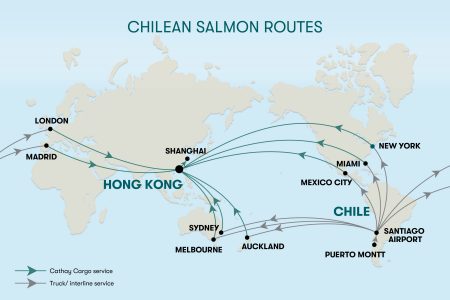Chilled salmon was an export market worth US$14.1bn in 2023. The main exporters were Norway, Sweden, Chile, Denmark and the UK, and while the fastest growing import market was the Chinese Mainland, it still lagged behind Poland, the US, France and Italy by volume that year.
Salmon freezes well but premium or superior grades of fish, which you would expect to be cooked to order in high-end restaurants or served in sushi or as sashimi, are exported chilled to preserve their quality. Given the significant distances between some export and import markets, speed is of the essence to keep this in-demand product fresh, necessitating movement by air.
Thanks to Cathay Cargo’s hub location, its global reach and the Cathay Fresh special solution, Cathay Cargo is ideally placed to capture a share of this important market. With freighter and passenger aircraft operations in Europe and South West Pacific, and excellent interline connections out of South America, Cathay Cargo’s network assures shippers that their consignments will move across the globe expeditiously. Furthermore, consignments will link into Cathay Cargo’s IATA CEIV Fresh accredited temperature-sensitive expertise as soon as possible as it moves into the growth markets of the Chinese Mainland and wider Asia – even if some of these routes appear disparate at first glance.
Chile to Asia
Area Cargo Manager Camilo Gallo’s team handles the salmon shipments from Chile, which currently total between 150 to 200 tonnes per week. “The vast majority of the premium-quality salmon we handle starts its journey from the coastal city of Puerto Montt, from where it is carefully trucked to Santiago Airport for its onward journey,” he says.








